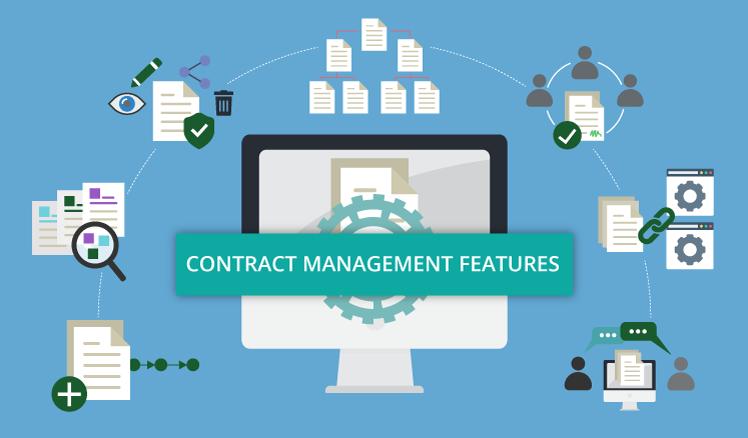
Contract management software revolutionizes how businesses handle contracts, offering a centralized platform to streamline processes. It simplifies contract creation, storage, and tracking, enabling organizations to manage agreements efficiently.
This software facilitates stakeholder collaboration, ensures compliance with regulatory requirements, and reduces the risk of errors or oversights. By providing a structured approach to contract management, businesses can enhance transparency, mitigate risks, and optimize their contractual relationships.
From small enterprises to multinational corporations, the adoption of contract management software is essential for improving operational efficiency and maximizing the value of contractual agreements.
Importance of Contract Management Software

By streamlining the contract lifecycle, software is pivotal in modern business operations. Its importance lies in its ability to centralize contract data, streamline processes, and enhance organizational visibility. By leveraging contract management software, businesses can track critical milestones, automate repetitive tasks, and ensure compliance with regulatory standards.
Moreover, it helps mitigate contract errors, missed deadlines, and non-compliance risks. The software facilitates seamless stakeholder collaboration, improves decision-making processes, and enhances operational efficiency. Whether managing vendor contracts, client agreements, or internal policies, contract management software empowers organizations to optimize their contract management practices, minimize costs, and drive business success in today’s dynamic marketplace.
Features to Look for in Free Contract Management Software

When considering free software, several vital features warrant attention to ensure optimal functionality and suitability for business needs. Firstly, robust document repository and organization capabilities are essential for efficiently storing and accessing contracts.
Automated alerts and notifications help keep stakeholders informed about important deadlines and updates. Customizable templates enable businesses to tailor contracts to their specific requirements swiftly. Role-based access controls ensure that sensitive information is protected and only accessible to authorized personnel.
Integration capabilities with other business systems also enhance workflow efficiency and data consistency. These features empower organizations to manage contracts effectively, improve collaboration, and mitigate risks, making them indispensable when evaluating free software solutions.
Top Free Contract Management Software Options
- Software A
- Software B
- Software C
Software A
Software A is a robust, user-friendly contract management solution to streamline contract-related processes. With its intuitive interface, Software A simplifies contract creation, storage, and tracking tasks. It offers comprehensive document management features, allowing users to organize and access contracts efficiently.
Moreover, Software A provides customizable workflows tailored to diverse business needs, enabling seamless collaboration among team members. Its real-time reporting and analytics capabilities offer valuable insights into contract performance and compliance status.
Additionally, Software A stands out for its user-friendly contract creation tools, facilitating quick and error-free contract generation. With Software A, organizations can enhance productivity, mitigate risks, and optimize their contract management practices effectively.
. Software B
Software B offers an intuitive and efficient solution for contract management tasks. With its user-friendly interface, Software B simplifies contract creation and collaboration processes. It provides real-time collaboration features, enabling teams to work seamlessly on contract-related tasks.
Additionally, Software B offers comprehensive reporting functionalities, allowing users to track contract status and performance effectively. Its customizable features cater to diverse business needs, enhancing flexibility and scalability. Software is valuable for organizations seeking to streamline contract management processes and improve efficiency.
. Software C
A stands out as a comprehensive solution for contract management needs. Its advanced search capabilities allow users to quickly locate specific contracts and related documents. Its robust version control mechanisms ensure data integrity and accuracy throughout the contract’s lifecycle.
Software C seamlessly integrates with other business applications, enhancing workflow efficiency and productivity. Moreover, its user-friendly interface makes it easy for users to navigate and utilize its features effectively. Organizations can streamline contract management processes and optimize productivity.
Comparison of Free Contract Management Software
When comparing free contract management software options, several factors come into play to determine the most suitable solution for business needs. Firstly, consider the features offered by each software, such as document organization, automated alerts, and customization options.
Evaluate the user interface and ease of navigation to ensure seamless adoption and usage across teams. Additionally, assess each piece of software’s scalability and integration capabilities to accommodate future growth and align with existing systems.
Consider factors like customer support quality and user reviews to gauge each solution’s overall satisfaction and reliability. By conducting a comprehensive comparison, businesses can identify the best free contract management software that meets their requirements and enhances contract management efficiency.
How to Choose the Best Free Contract Management Software

Choosing the best free contract management software involves thoroughly assessing specific business requirements and available options. Start by identifying key features for efficient contract management, such as document organization, automation capabilities, and integration with existing systems.
Prioritize user-friendly interfaces and customizable workflows to ensure seamless adoption and usability. Consider scalability to accommodate future growth and the ability to handle increased contract volumes.
Additionally, evaluate the vendor’s reputation, customer support quality, and user reviews to gauge reliability and satisfaction. By conducting diligent research and testing trial versions, businesses can select the best free software that aligns with their needs, enhances productivity, and mitigates risks effectively.
Tips for Successful Implementation
Successful implementation of contract management software requires careful planning and execution. Start by establishing clear objectives and goals for the implementation process, ensuring alignment with organizational priorities.
Engage key stakeholders from various departments to gain buy-in and gather insights into specific requirements. Provide comprehensive training sessions to ensure users can effectively use the software. Foster a culture of continuous improvement by encouraging feedback and addressing concerns promptly.
Develop a detailed implementation timeline with measurable milestones to track progress and ensure accountability. Allocate sufficient resources and support for the implementation phase, including dedicated personnel and technical assistance. Regularly review and assess performance metrics to identify areas for optimization and refinement. By following these tips, organizations can successfully implement contract management software and maximize its benefits.
Case Studies: Real-Life Examples of Successful Implementation
Case studies offer valuable insights into real-world implementations of contract management software, showcasing its impact on businesses. These studies highlight organizations’ challenges and how the software addresses them effectively.
For example, a manufacturing company may detail how software streamlines supplier agreements, reducing procurement cycle times and costs. Similarly, a healthcare organization might demonstrate how the software enhanced regulatory compliance and reduced legal risks associated with patient contracts.
By sharing success stories and measurable outcomes, case studies illustrate the tangible benefits of contract management software, including improved efficiency, enhanced collaboration, and reduced operational costs. Analyzing case studies enables businesses to glean best practices, identify potential use cases, and make informed decisions about implementing software in their environments.
Addressing Common Concerns and Misconceptions
Addressing common concerns and misconceptions surrounding software is crucial for fostering understanding and confidence in its adoption. A common worry is data security, which can be tackled with robust encryption protocols and access controls.
Another misconception is the implementation complexity; however, organizations can smoothly integrate the software into their workflows with proper planning and support. Additionally, scalability concerns can be mitigated by choosing a software solution that grows with the organization’s needs.
It’s also important to dispel misconceptions about the affordability and accessibility of contract management software, as many solutions offer flexible pricing plans and user-friendly interfaces. By addressing these concerns transparently, businesses can effectively make informed decisions and reap the benefits of contract management software.
Future Trends in Contract Management Software

Future trends in contract management software are poised to revolutionize how businesses handle contracts and streamline operations. One prominent trend is integrating artificial intelligence (AI) and machine learning algorithms, enabling software to automate repetitive tasks, analyze contract data, and predict trends.
Blockchain technology is another emerging trend, offering enhanced security, transparency, and immutability in contract management processes. Moreover, software is expected to become more mobile-friendly, allowing users to access and manage contracts anywhere.
Integration with other enterprise systems, such as CRM and ERP platforms, will also continue to evolve, facilitating seamless data exchange and workflow automation. By embracing these future trends, businesses can optimize efficiency, reduce risks, and unlock new opportunities in contract management.
Conclusion
In conclusion, software emerges as a pivotal tool for businesses seeking to streamline contract processes, enhance compliance, and mitigate risks effectively. By centralizing contract data, automating workflows, and providing real-time visibility, this software empowers organizations to optimize contract lifecycles and drive operational excellence.
The importance of selecting the right software cannot be overstated, as it directly impacts efficiency, productivity, and overall business success. As businesses navigate the complexities of contract management, it’s essential to prioritize user adoption, ongoing support, and alignment with evolving business needs.
Embracing emerging trends such as AI, blockchain, and mobile accessibility will further propel the evolution of software. By leveraging these technologies, businesses can stay ahead of the curve, adapt to changing market dynamics, and unlock new opportunities for growth and innovation.
2. What are the limitations of free contract management software?
Free contract management software may offer limited features, scalability, integration capabilities, and vendor support compared to paid options, necessitating careful evaluation and consideration of organizational requirements.
3. How can businesses ensure successful user adoption of contract management software?
Successful user adoption requires comprehensive training, stakeholder engagement, clear communication, and performance monitoring to optimize usability, productivity, and ROI.
4. Are there any hidden costs associated with free contract management software?
Organizations should be aware of potential hidden costs such as customization fees, add-ons, data migration costs, support and maintenance fees, and hidden charges for premium features or usage thresholds.
5. What are the future trends shaping the evolution of contract management software?
Key trends include AI-powered automation, blockchain technology for enhanced security, predictive analytics







